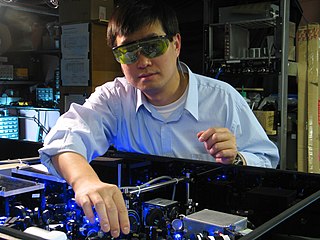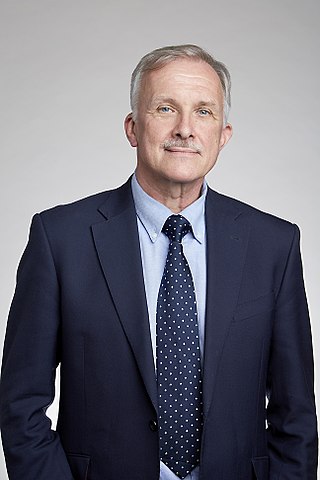Related Research Articles

Gérard Albert Mourou is a French scientist and pioneer in the field of electrical engineering and lasers. He was awarded a Nobel Prize in Physics in 2018, along with Donna Strickland, for the invention of chirped pulse amplification, a technique later used to create ultrashort-pulse, very high-intensity (petawatt) laser pulses.
Xi-Cheng Zhang is a Chinese-born American physicist, currently serving as the Parker Givens Chair of Optics at the University of Rochester, and the director of the Institute of Optics. He is also the Chairman of the Board and President of Zomega Terahertz Corporation.

Jun Ye is a Chinese-American physicist at JILA, National Institute of Standards and Technology, and the University of Colorado Boulder, working primarily in the field of atomic, molecular and optical physics.
Michael Dennis Feit is an American physicist at the Lawrence Livermore National Laboratory, California.
André Dieter Bandrauk is a Canadian chemist and distinguished academic who is a professor of Theoretical chemistry at the University of Sherbrooke in Montreal.
Jan M. Rost is a German theoretical physicist and director at the Max Planck Institute for the Physics of Complex Systems in Dresden heading the research department Finite Systems. He was awarded the status of Fellow in the American Physical Society, after nomination by the Division of Atomic, Molecular & Optical Physics in 2007, for seminal investigations of correlated doubly excited states, threshold fragmentation in few-body Coulombic systems and small clusters, pendular states of linear molecules, and for elucidating the role of correlation and relaxation in ultracold plasmas and Rydberg gases.
Karl Krushelnick is an American plasma physicist located at the University of Michigan. He was awarded the status of Fellow in the American Physical Society, after he was nominated by the university's Division of Plasma Physics in 2007, for "pioneering contributions to experimental high-intensity laser plasma physics including the production of high-quality relativistic electron beams, energetic proton beams and the development of techniques to measure very large magnetic fields in intense laser-produced plasmas."

Albert Stolow is a Canadian physicist. He is the Canada Research Chair in Molecular Photonics, Full Professor of Chemistry & Biomolecular Sciences and of Physics, and a Member of the Ottawa Institute for Systems Biology at the University of Ottawa. He is the founder and an ongoing member of the Molecular Photonics Group at the National Research Council of Canada. He is adjunct professor of Chemistry and of Physics at Queen's University in Kingston, and a Graduate Faculty Scholar in the Department of Physics, University of Central Florida and a Fellow of the Max-Planck-uOttawa Centre for Extreme and Quantum Photonics. In 2008, he was elected a Fellow in the American Physical Society, nominated by its Division of Chemical Physics in 2008, for contributions to ultrafast laser science as applied to molecular physics, including time-resolved studies of non-adiabatic dynamics in excited molecules, non-perturbative quantum control of molecular dynamics, and dynamics of polyatomic molecules in strong laser fields. In 2008, Stolow won the Keith Laidler Award of the Canadian Society for Chemistry, for a distinguished contribution to the field of physical chemistry, recognizing early career achievement. In 2009, he was elected a Fellow of the Optical Society of America for the application of ultrafast optical techniques to molecular dynamics and control, in particular, studies of molecules in strong laser fields and the development of new methods of optical quantum control. In 2013, he was awarded the Queen Elizabeth II Diamond Jubilee Medal (Canada). In 2017, Stolow was awarded the Earle K. Plyler Prize for Molecular Spectroscopy and Dynamics of the American Physical Society for the development of methods for probing and controlling ultrafast dynamics in polyatomic molecules, including time-resolved photoelectron spectroscopy and imaging, strong field molecular ionization, and dynamic Stark quantum control. In 2018, Stolow was awarded the John C. Polanyi Award of the Canadian Society for Chemistry “for excellence by a scientist carrying out research in Canada in physical, theoretical or computational chemistry or chemical physics”. In 2020, he became Chair of the Division of Chemical Physics of the American Physical Society. His group's research interests include ultrafast molecular dynamics and quantum control, time-resolved photoelectron spectroscopy and imaging, strong field & attosecond physics of polyatomic molecules, and coherent non-linear optical microscopy of live cells/tissues, materials and geological samples. In 2020, Stolow launched a major new high power ultrafast laser facility at the University of Ottawa producing high energy, phase-controlled few-cycle pulses of 2 micron wavelength at 10 kHz repetition rate. These are used for High Harmonic Generation to produce bright ultrafast Soft X-ray pulses for a new Ultrafast Xray Science Laboratory.
Ravinder Kumar Jain is an American engineer, physicist, and academic from the University of New Mexico. He was awarded the status of Fellow in the American Physical Society, after they were nominated by their Forum on Industrial and Applied Physics in 2008, for pioneering contributions in several areas of applied physics, including discovery of plasmon-mediated light-emission from tunnel junctions, seminal studies of nonlinear optics in semiconductors and optical fibers, and the invention of several important ultrashort pulse lasers and fiber lasers.
Eric Borguet from the Temple University, was awarded the status of Fellow in the American Physical Society, after they were nominated by their Division of Chemical Physics in 2009, for "his seminal contributions to our understanding of optical, molecular and electronic phenomena at buried interfaces, complex interfaces, and nanosystems; and for the development of novel experimental tools and methodologies, particularly the development of fluorescent labeling of surface species."
Farhat N. Beg from the University of California, San Diego, was awarded the status of Fellow in the American Physical Society, after he was nominated by his Division of Plasma Physics in 2009, for contributions to the understanding of physics of short pulse high intensity laser matter interactions and pulsed power driven dense Z-pinches. His empirical scaling of hot electron temperature versus laser intensity has contributed significantly to the understanding of relativistic electron generation and transport in matter. He was the recipient of the Department of Energy Early Career Award in 2005 as well as the IEEE Early Achievement Award in 2008. He also has been a fellow of the IEEE since 2011. He currently is the director of the Center for Energy Research at UCSD with a focus on Inertial Confinement Fusion.'
James T. Linnemann from Michigan State University, was awarded the status of Fellow in the American Physical Society, after he was nominated by the Division of Particles and Fields in 2009, for original research in high energy physics and particle astrophysics through electronics and software applications, seminal contributions to the discoveries of the top quark and TeV gamma-ray sources, searches for supersymmetry, and applications of statistics.
János Bergou is a Hungarian physicist and academic who is currently a professor at Hunter College in New York. In 2009, he was awarded the status of Fellow in the American Physical Society, after they were nominated by their Division of Laser Science in 2009, for "outstanding work in quantum optics and quantum information, in particular work on the theory of correlated emission lasers, the effect of pump statistics on the nature of the electromagnetic field produced in lasers and micromasers, and on quantum state discrimination."
Jens G. Eggers from the University of Bristol, was awarded the status of Fellow in the American Physical Society, after they were nominated by their Division of Fluid Dynamics in 2009, for applications of the ideas of singularities to free-boundary problems such as jet breakup, drop formation, air entrainment, thin-film dynamics including wetting, dewetting and contact line motions, and with further applications to polymeric flows and models for granular dynamics.
Hans-Jürgen Troe is a German physicist from the University of Göttingen. He was awarded the status of Fellow in the American Physical Society, after he was nominated by his Division of Chemical Physics in 2009, for "experimental and theoretical research on the kinetics of unimolecular reactions of neutral and ionic molecules, and especially for the development of the statistical adiabatic channel model and its application to unimolecular processes from low to high pressures." Was awarded the Otto Hahn Prize in 2015.
Konstantin Lvovich Vodopyanov is a Russian physicist from Stanford University. He was awarded the status of Fellow in the American Physical Society, after they were nominated by their Division of Laser Science in 2009, for "development of a new class of broadly-tunable infrared and terahertz sources based on nonlinear-optical conversion in bulk, micro- and nano- structured media, and their application to spectroscopic studies including demonstration of electromagnetically-induced transparency in quantum wells."

(James) Roy Taylor is Professor of Ultrafast Physics and Technology at Imperial College London.
Tamar Seideman is the Dow Chemical Company Professor of Chemistry and Professor of Physics at Northwestern University. She specialises in coherence spectroscopies and coherent control in isolated molecules and dissipative media as well as in ultrafast nanoplasmonics, current-driven phenomena in nanoelectronics and mathematical models.
Peter J. Delfyett Jr is an American engineer and Pegasus Professor and Trustee Chair Professor of Optics, ECE & Physics at the University of Central Florida College of Optics and Photonics.

Debabrata Goswami FInstP FRSC, is an Indian chemist and the Prof. S. Sampath Chair Professor of Chemistry, at the Indian Institute of Technology Kanpur. He is also a professor of The Department of Chemistry and The Center for Lasers & Photonics at the same Institute. Goswami is an associate editor of the open-access journal Science Advances. He is also an Academic Editor for PLOS One and PeerJ Chemistry. He has contributed to the theory of Quantum Computing as well as nonlinear optical spectroscopy. His work is documented in more than 200 research publications. He is an elected Fellow of the Royal Society of Chemistry, Fellow of the Institute of Physics, the SPIE, and The Optical Society. He is also a Senior Member of the IEEE, has been awarded a Swarnajayanti Fellowship for Chemical Sciences, and has held a Wellcome Trust Senior Research Fellowship. He is the third Indian to be awarded the International Commission for Optics Galileo Galilei Medal for excellence in optics.
References
- ↑ "APS Fellowship". www.aps.org. Retrieved 2017-04-20.
- ↑ "APS Fellow Archive". www.aps.org. Retrieved 2017-04-20.
- ↑ "APS Fellows 2009". www.aps.org. Retrieved 2017-04-20.